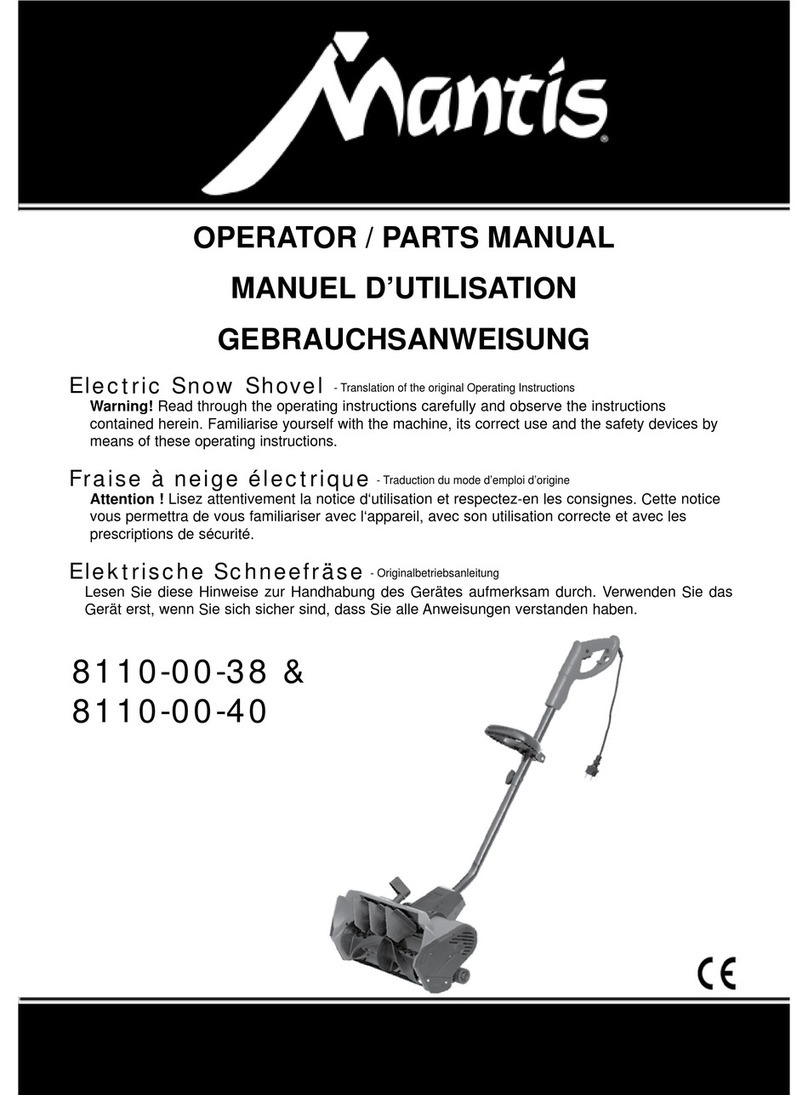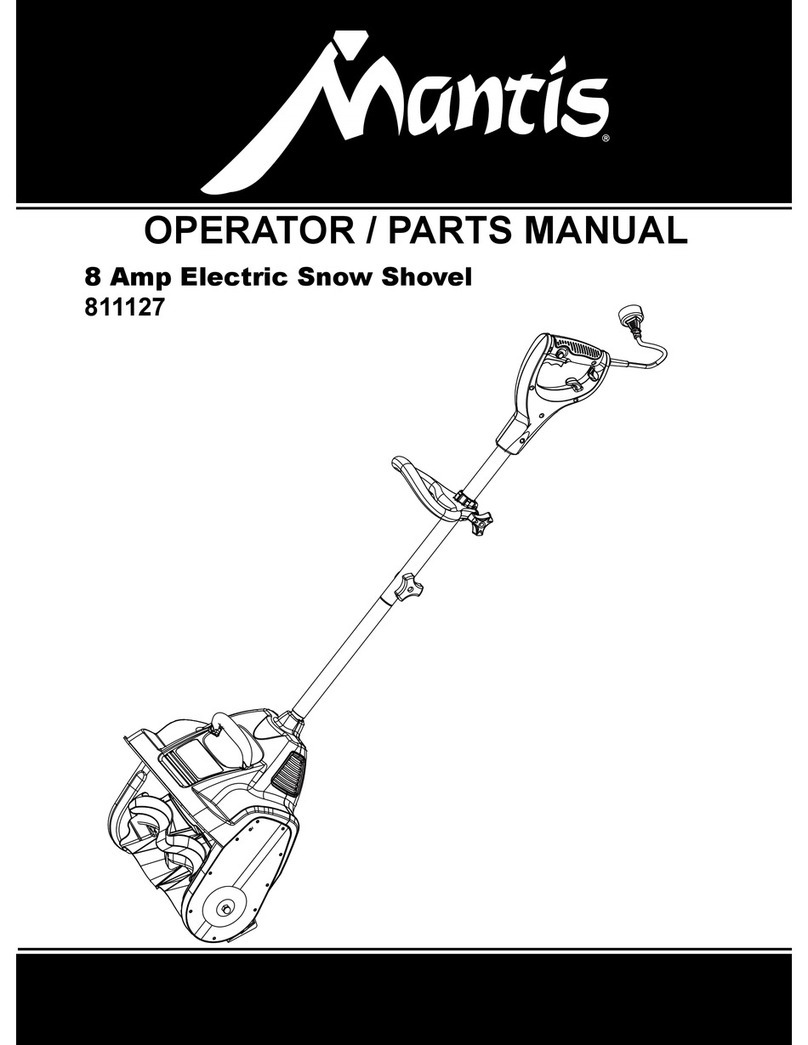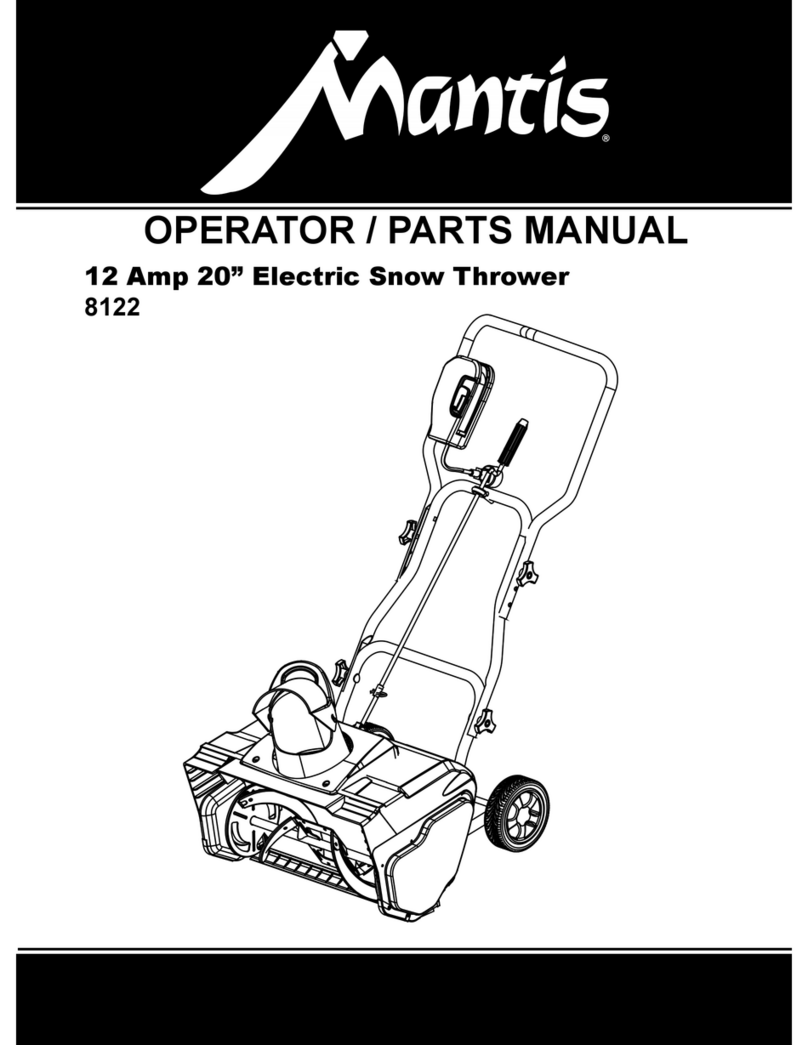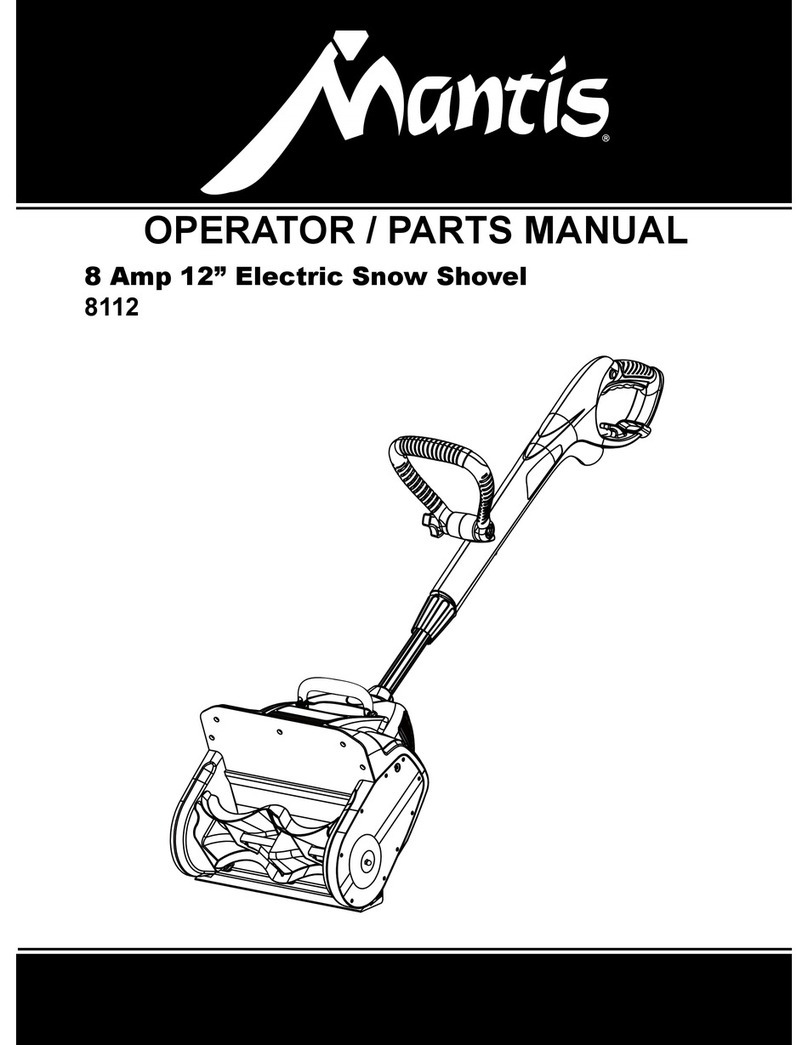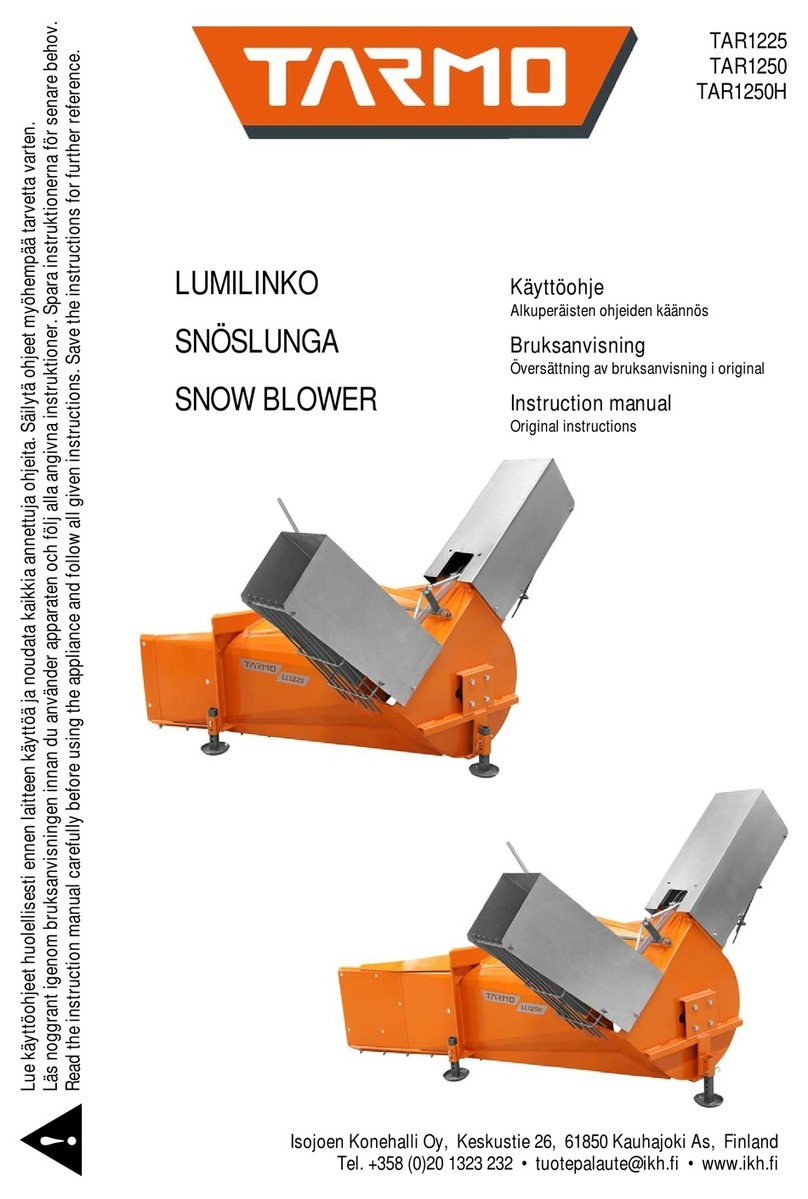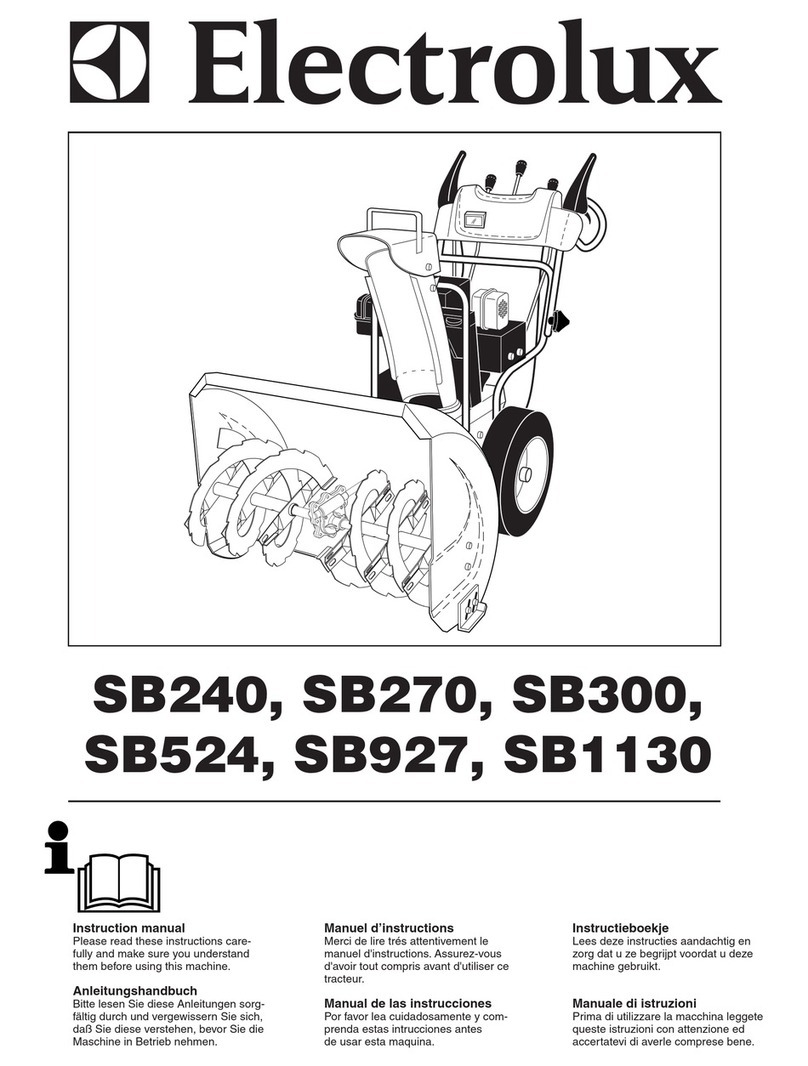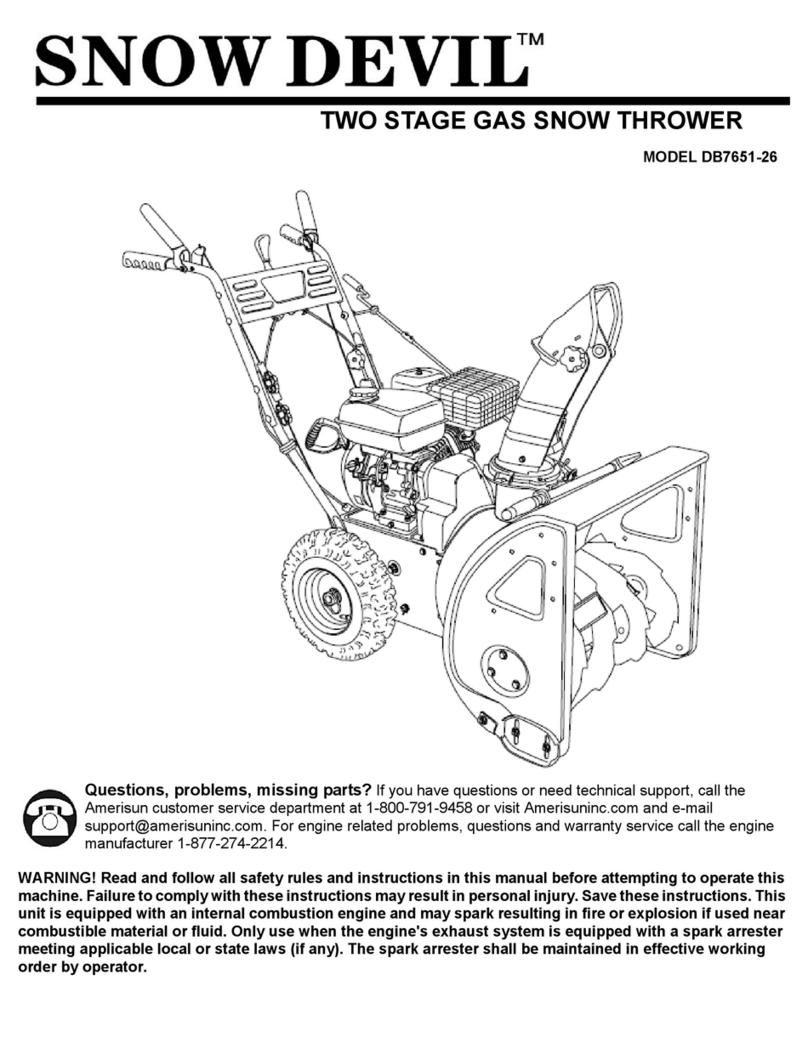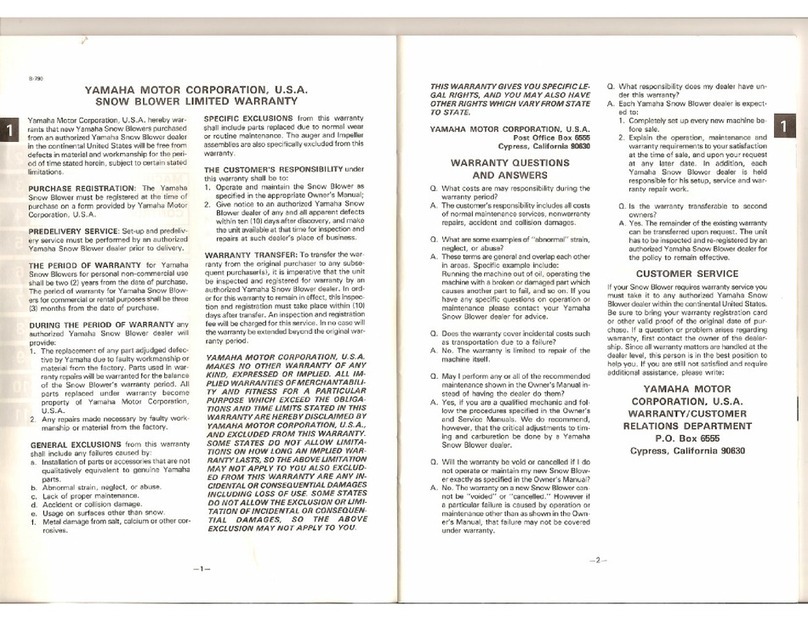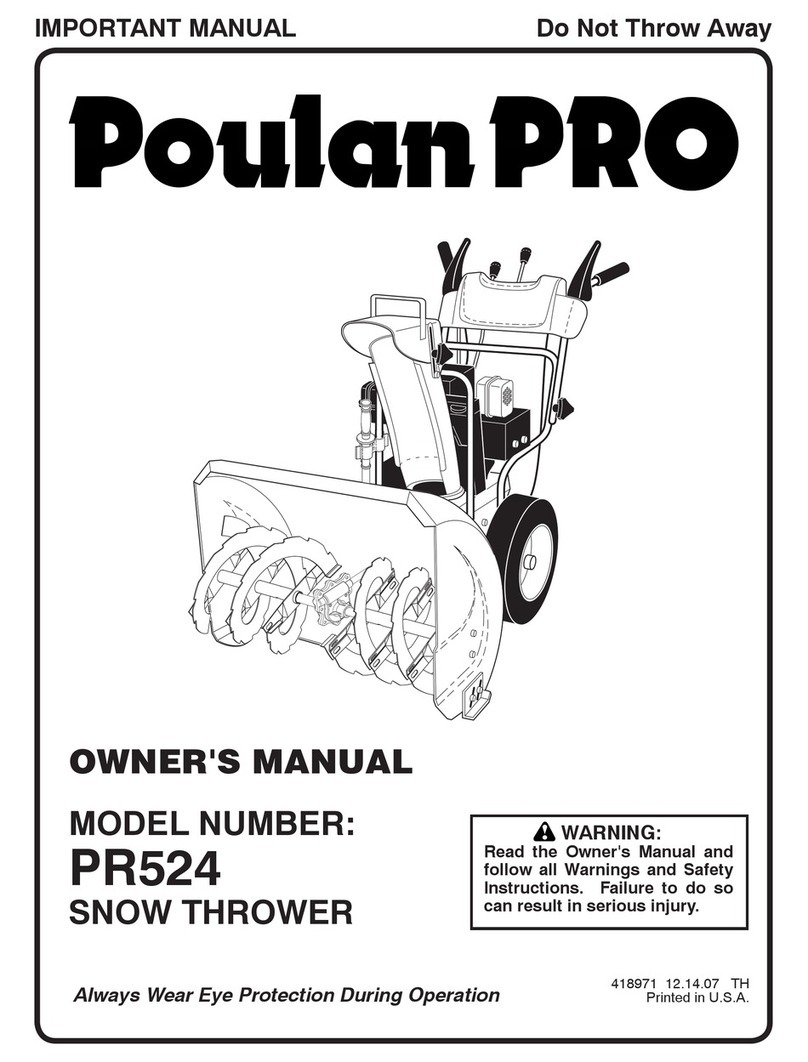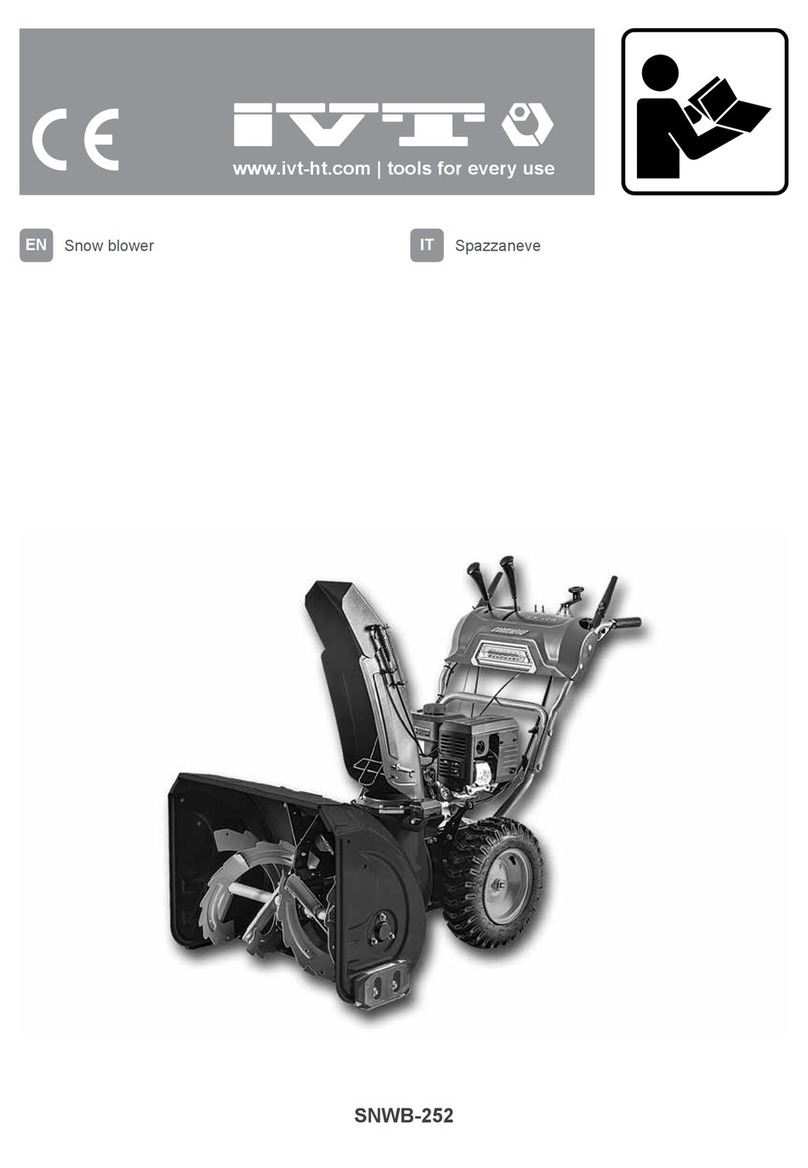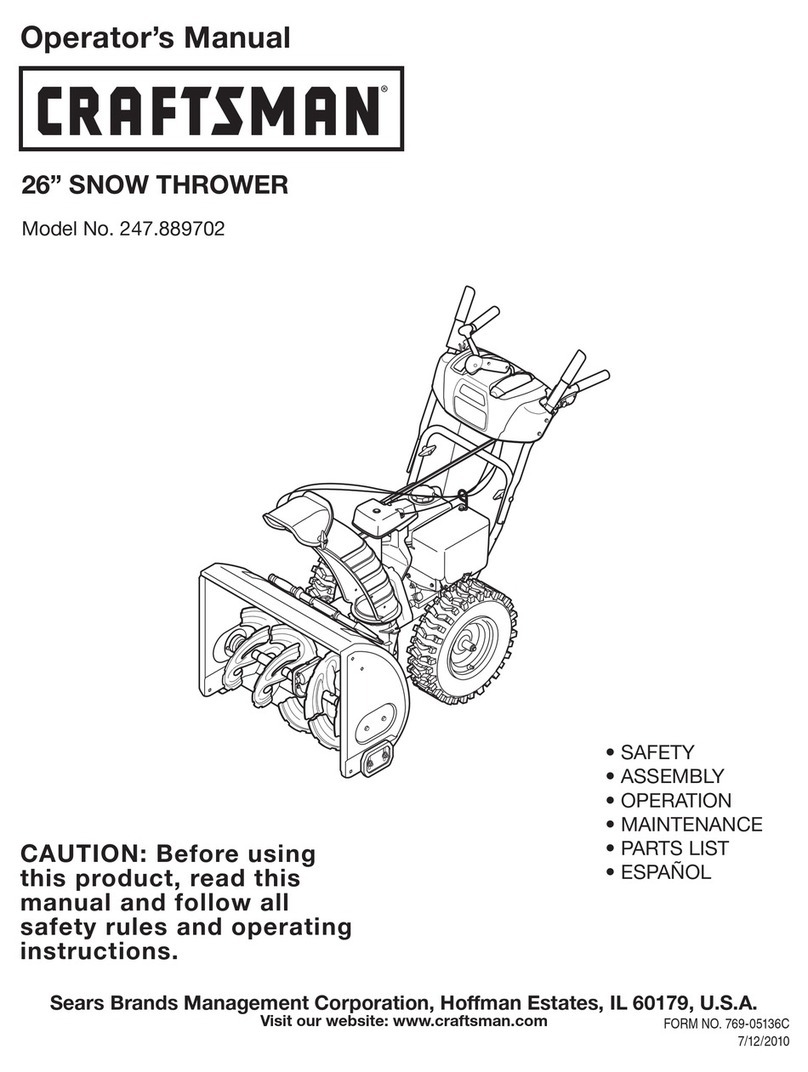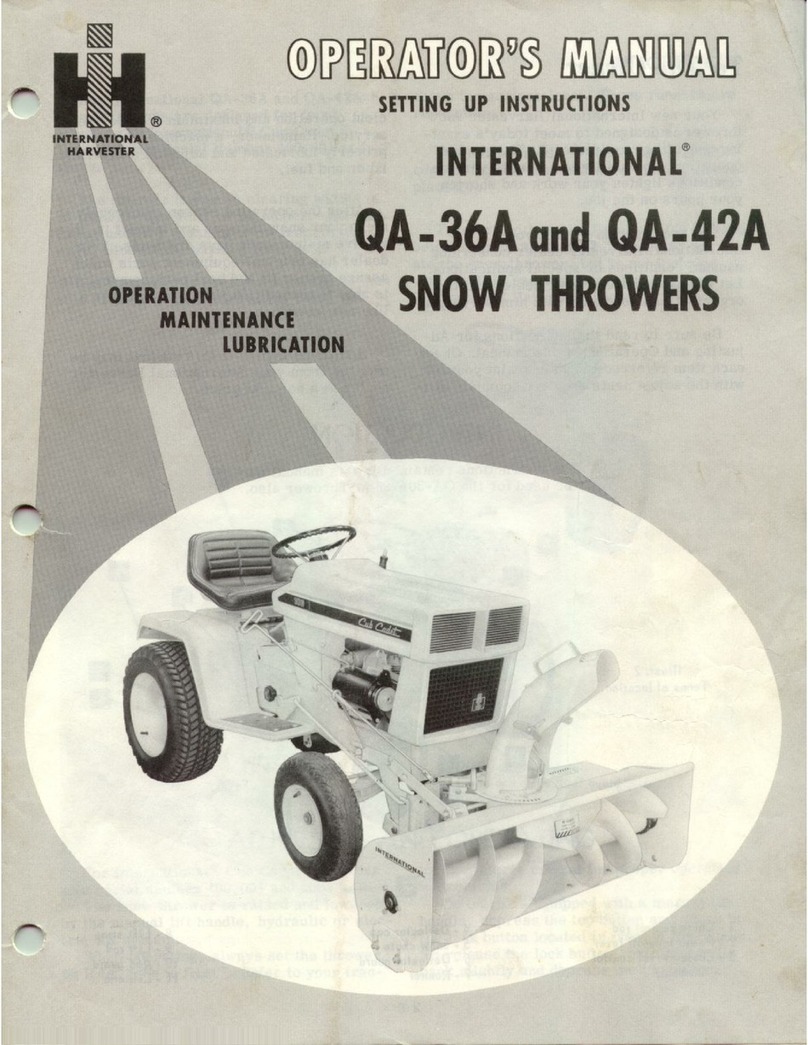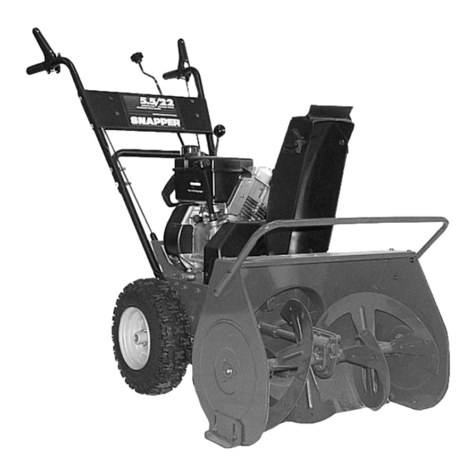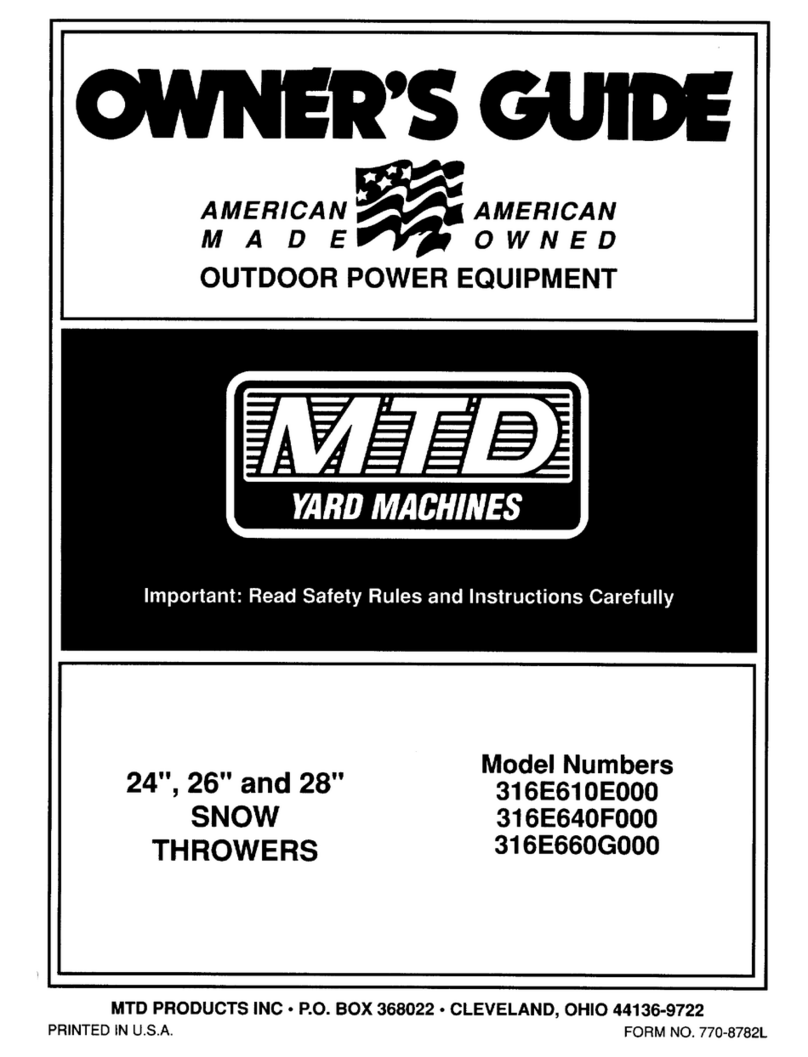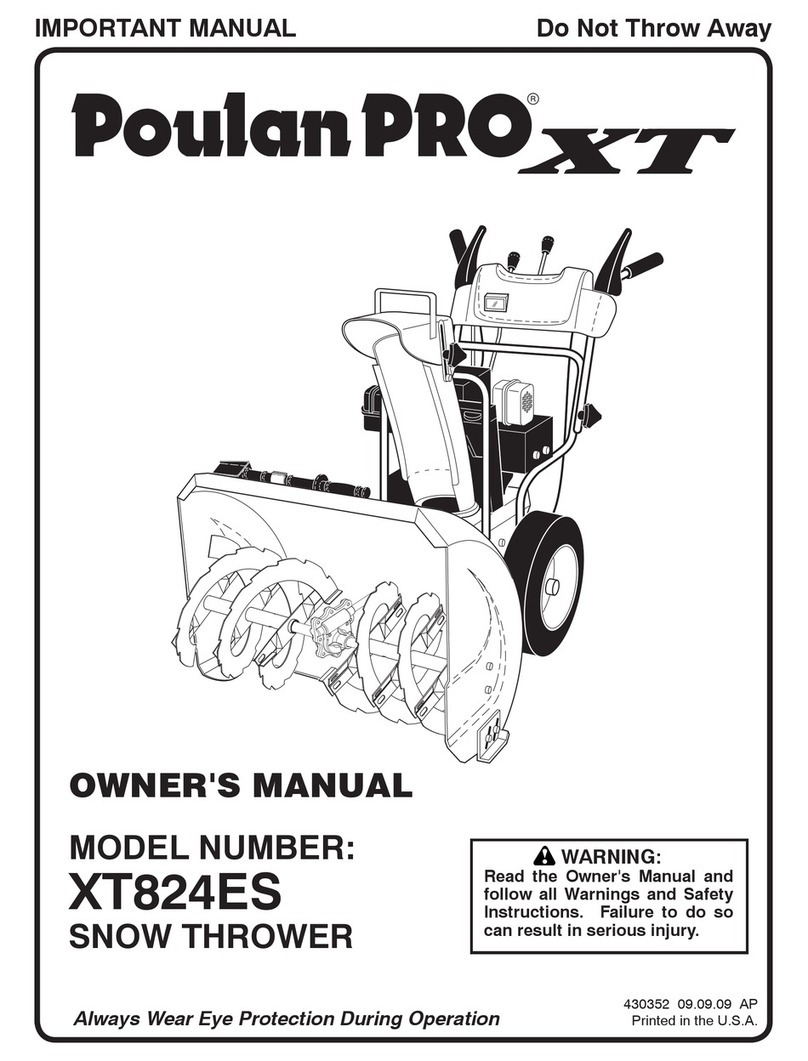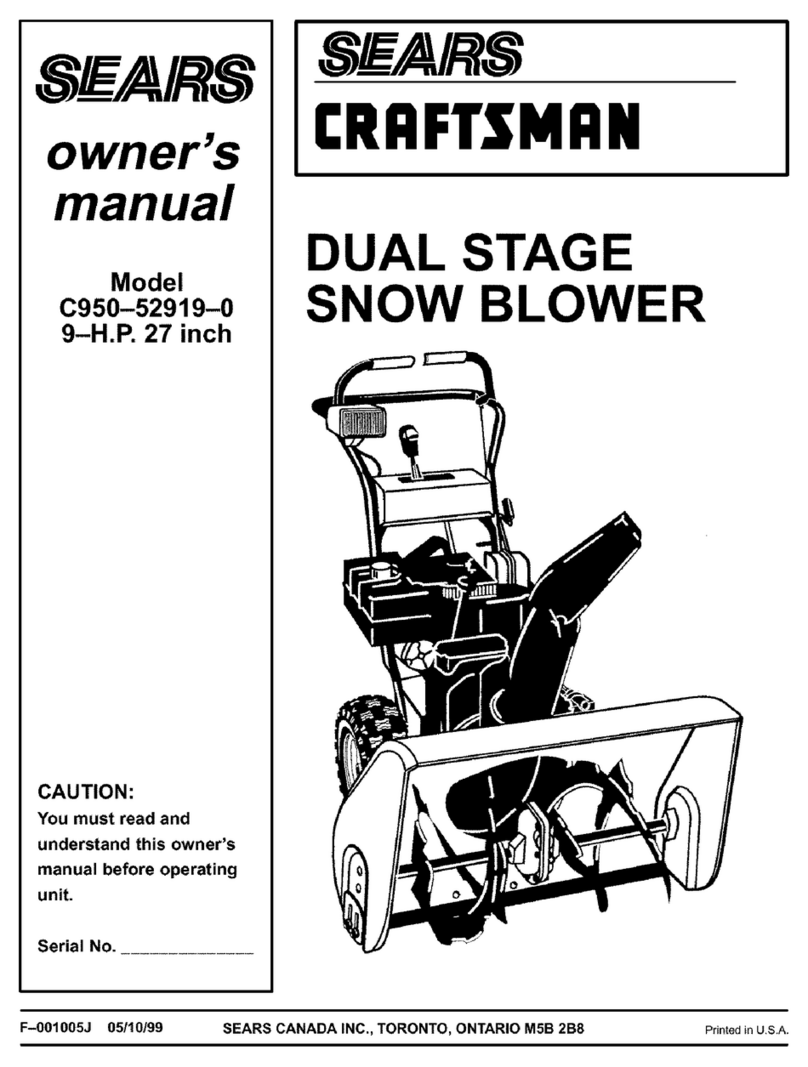Mantis 8120-00-38 Programming manual

OPERATOR / PARTS MANUAL
MANUEL D’UTILISATION
GEBRAUCHSANWEISUNG
Electric Snow Thrower
Warning! Read through the operating instructions carefully and observe the instructions contained
herein. Familiarise yourself with the machine, its correct use and the safety devices by means of
these operating instructions.
Fraise à neige électrique
Attention ! Lisez attentivement la notice d‘utilisation et respectez-en les consignes. Cette notice
vous permettra de vous familiariser avec l‘appareil, avec son utilisation correcte et avec les
prescriptions de sécurité.
Elektrische Schneefräse
Lesen Sie diese Hinweise zur Handhabung des Gerätes aufmerksam durch. Verwenden Sie das
Gerät erst, wenn Sie sich sicher sind, dass Sie alle Anweisungen verstanden haben.
- Originalbetriebsanleitung
- Traduction du mode d’emploi d’origine
- Translation of the original Operating Instructions
8120-00-38 &
8120-00-40


Contact us at www.mantis.uk.com
1
This Operator / Parts Manual is part of the machine. Suppliers of both new and
second-hand machines must make sure that this manual is provided with the
machine.
Thank you for purchasing this Mantis product. You have purchased a world class product, one of the best designed and built anywhere.
This machine comes with an Operator / Parts Manual. The useful life and good service your receive from this machine depends to a
large extent on how well you read and understand this manual. Treat your machine properly, lubricate and adjust it as instructed, and
it will give you many years of reliable service.
Your safe use of this Mantis product is one of our prime design objectives. Many safety features are built in, but we also rely on your
good sense and care to achieve accident-free operation. For best protection, study the manuals thoroughly. Learn the proper operation
of all controls. Observe all safety precautions. Follow all instructions and warnings completely. Do not remove any safety features.
Make sure those who operate this machine are as well informed and careful in its use as you are.
Mantis designs and builds its equipment to serve many years in a safe and productive manner. For longest life, use this machine only
as directed in the manuals, keep in good repair and follow safety warnings and instructions. You’ll always be glad you did.
Schiller Grounds Care, Inc.
1028 Street Road
Southampton, PA 18966 U.S.A.
PHONE (800) 366-6268 • FAX (215)-956-3855
IMPORTANT MESSAGE
Table of Contents
Parts List..............................................................................
Illustrations...........................................................................
Technical Data.....................................................................
Explanation of Warning Symbols.........................................
SafetyInstructions................................................................
Getting Started.....................................................................
Operation..............................................................................
Maintenance.........................................................................
Storage.................................................................................
RepairService......................................................................
Waste Disposal and Environmental Protection....................
MANTIS Limited Warranty....................................................
EC Declaration of Conformity..............................................
2
3 - 5
6
7
8-10
10
10-11
11-12
12
12
12
13
15

Electric Snow Thrower Operator’s Manual
FR - LISTE DES PIECES
1. Poignée, partie supérieure
2. Bouton de connexion
3. Panneau de commande
4. Déecteur de goulotte
5. Goulotte d’éjection
6. Vis sans n
7. Capot latéral
8. Carter
9. Poignée, partie inférieure
10. Boîtier de commutation
11. Revêtement de la poignée
12. Câble réseau avec connecteur
13. Décharge de traction du câble
14. Bielle pivotante pour le canal
d‘éjection
15. Vis de blocage
16. Roue (2x)
GB - PaRTS LIST
1. H a n d l e s h a f t u p p e r p a r t
2. Connection knob
3. Operation panel
4. Chute Deector
5. Discharge Chute
6. Auger
7. Side cover
8. Housing
9. Handle shaft lower part
10. Switch box
11. Handle sponge
12. Mains cable with plug
13. Cable strain relief
14. Adjusting rod for eject channel
15. Locking screw
16. Wheel (2x)
DE - TEILELISTE
1. Griff, oberer Teil
2. Verbindungsknopf
3. Griffstrebe (Führung Drehge-
stänge)
4. Gelenkkappe (verstellbarer
Auswurfkanal)
5. Auswurfkanal
6. Schnecke
7. Seitenabdeckung
8. Gehäuse
9. Griff, unterer Teil
10. 2-Punkt-Sicherheitsschalter
11. Griffpolster
12. Netzleitung mit Stecker
13. Kabelzugentlastung
14. Drehgestänge für Auswurfkanal
15. Feststellschraube
16. Rad (2x)
2
1
3
4
5
67
8
9
10
11
12
13
14
16
15
2
Parts List

Contact us at www.mantis.uk.com
3
12
34
564
13
5
Illustrations (Cont.‘d)

Electric Snow Thrower Operator’s Manual
4
10
11
3
78
12
9
Illustrations (Cont.‘d)

Contact us at www.mantis.uk.com
5
17 18
14
15 16
13
Illustrations (Cont.‘d)

Electric Snow Thrower Operator’s Manual
6
Technical Data
Model: Electric Snow Thrower 8120-00-38 & 8120-00-40
Rated Voltage 230-240 V~/50 Hz
Power 2000 W
Plowing Capacity Max. 720 m2/hr
Idling/Rotation Speed n02300 rpm
Working width 460 mm / 18.1“
Working height 300 mm / 11.8“
Rotating angle 180°
Plow depth and width ca. 2,3 cm und 51 cm / 0.9” and 20”
Max Spraying Distance 5-6 m / 5,47 - 6,56 yd
Weight 15 kg / 33,1 lbs.
Sound power level 97 dB(A)
Sound pressure level 86 dB(A) K=3.0 dB(A)
Vibration 2.5 m/s2K=1.5 m/s2
Protection Class ‖
Protection degree IPX5

Contact us at www.mantis.uk.com
7
Explanation of Warning Symbols
These Operating Instructions describe safety symbols and international symbols and pictographs that may be applied
to the device.
Read these instructions for use carefully
WARNING – Keep other persons away from the danger zone!
Attention: Environmental Protection! This device may not be disposed of with general/
household waste. Dispose of only at a designated collection point.
Severing of ngers or hand---Impeller blade
Attention, danger!
Cutting or entanglement of foot ---Rotating auger.
Tool carries on running after being switched off!

Electric Snow Thrower Operator’s Manual
8
IMPORTANT!
Safety Instructions
GENERAL SAFETY INSTRUCTIONS
Warning:Readallinstructions.Failuretofollowallinstruc-
tions listed below may result in electric shock, re and/
or serious personal injury. The term “power tool” in all of
the warnings listed below refers to your mains-operated
(corded) power tool.
SAVE THESE INSTRUCTIONS
1) WORK AREA
a) Keepworkareacleanand well lit. Clutteredanddark
areas invite accidents.
b) Donotoperatepower tools inexplosiveatmosphere,
such as in the presence of ammable liquids, gases,
or dust. Power tools create sparks which may ignite
the dust or fumes.
c) Keepchildren,petsandbystandersawaywhile from
work area. Be aware that the normal noise of the
machine when turned on may make it difcult for
you to hear approaching people.
2) ELECTRICAL SAFETY
a) Electricalplugs mustmatchthe outlet. Never modify
the plug in any way. Do not use any adapter plugs
with earthed (grounded) power tools. Unmodied
plugs and matching outlets will reduce risk of
electric shock.
b) Avoid body contact with earthed or grounded sur-
facessuchaspipes, radiators, ranges,andrefrigera-
tors. There is an increased risk of electric shock if
your body is earthed or grounded.
c) Do not expose power tools to rain or wet snow.
Water entering a power tool will increase the risk
of electric shock.
d) Do not abuse the cord. Never use the cord for car-
rying, pulling or unplugging the power tool. Keep
cord away from heat, oil, sharp edges or moving
parts. Damaged or entangled cords increase the
risk of electric shock.
e) Whenoperatingapowertooloutdoors, an extension
cord suitable for outdoor use and an RCD device
must be used. Use of a cord and RCD suitable for
outdoor use reduces the risk of electric shock.
3) PERSONAL SAFETY
a) Stay alert, watch what you are doing and use com-
mon sense when operating a power tool. Do not
use a power tool while you are tired or under the
inuence of drugs, alcohol, or medication. A moment
ofinattentionwhile operating power tools may result
in serious personal injury.
b) Use safety equipment. Always wear eye protection.
Safety equipment such as a dust mask, non-skid
safetyshoes,hardhat, or hearingprotectionusedfor
appropriate conditions will reduce personal injuries.
c) Avoid accidental starting. Ensure the switch is in
the off-position before plugging in. Carrying power
tools with your nger on the switch or plugging in
powertoolsthathave the switchoninvitesaccidents.
d) Remove any adjusting key or wrench before turning
the tool on. A wrench or a key that is left attached
to a rotating part of the power tool may result in
personal injury.
e) Do not overreach. Keep proper footing and balance
atalltimes. Thisenablesbettercontrolofthepower
tool in unexpected situations.
f) Dressproperly.Donotwear looseclothingorjewelry.
Keepyourhair, clothing, and gloves awayfrommov-
ing parts. Loose clothes, jewelry or long hair can be
caught in moving parts.
g) If devices are provided for the connection of dust
extractionandcollectionfacilities,ensurethat these
are connected and properly used. Use of these
devices can reduce dust-related hazards.
4) POWER TOOLS USE AND CARE
a) Do not force the power tool. Use the correct power
tool for your application. The correct power tool will
do the job better and safer at the rate from which
it was designed.
b) Donotusethe power tooliftheswitch does notturnit
on and off.Any power tool that can not be controlled
with the switch is dangerous and must be repaired.
c) Disconnect the plug from the power source before
making any adjustments, changing accessories,
or storing power tools. Such preventive safety
measures reduce the risk of starting the power tool
accidentally.
d) Storeidlepowertools outofthereachof childrenand
donotallowpersons unfamiliarwiththepowertool or
these instructions to operate the power tool. Power
toolsaredangerousinthehandsofuntrainedusers.
e) Maintain power tools. Check for misalignment or
binding of moving parts, breakage of parts, and
any other conditions that may affect the power tools
operation.Ifdamaged,havethepowertool repaired
before use. Many accidents are caused by poorly
maintained power tools.
f) Keep cutting tools sharp and clean. Properly main-
tainedcuttingtoolswithsharpcuttingedges are less
likely to bind and are easier to control.
g) Use the power tool, accessories and tool bits etc.,
in accordance with these instructions and in the
manner intended for the particular type of power
tool, taking into account the working conditions and
the work to be performed. Use of the power tool for
operations different from intended could result in a
hazardous situation.
5) SERVICE
a) Have your power tools serviced by a qualied re-
pair person using only identical replacement parts.
This will ensure that the safety of the power tools
is maintained.

Contact us at www.mantis.uk.com
9
ADDITIONAL SAFETY RULES FOR SNOW THROWER
• Know your tool. Read owner’s manual carefully. Learn
its applications and limitations as well as the specic
potential hazards related to this tool.
• Do not operate this unit when tired, ill or under the inu-
ence of alcohol, drugs, or medication.
• All guards and safety attachments must be installed
properly before using the unit.
• Inspect the unit before use. Ensure the parts are in-
stalled correctly and secure.
• Cleartheareatobeplowedbeforeeach use.Removeall
objectssuchasrocks,brokenglass, nails, wire, orstring
which can be thrown or become entangled in this tool.
• Keep the area of operation clear of all persons, particu-
larly children and pets.
• Avoid dangerous environment. Don’t use power tools
in damp or wet locations or expose to rain. Keep work
area well lit.
• Keep work area clean. Cluttered areas and benches
invite accidents.
• Be cautious to avoid electric shock. When using the
machine keep your body away from different ground
terminal of power (e.g. upper and lower water pipes,
outer frame of heating equipment, microwave oven, or
in a place that is locked.
• The machine should be stored carefully and safely in a
dry environment when not used, far from the reach of
children, or in a place that is locked.
• Please do not use the machine in any purposes other
thanitisdesignedfor, otherwise,itmaycausemechani-
cal defaults or serious damage or injuries.
• Special care should be drawn to the following issues
when using this machine: operation methods, proce-
dures, surroundings, and environment states, etc.
• When using this machine, the user should be cautious
about the nearby status or changes: The user should
constantly observe the position and movement of other
people, nearby window, vehicles, obstacles, etc. Exer-
cise caution to nd any small piece of rocks or other
articles in the snow to avoid them from ying out and
causing personal injury.
• In case of following conditions, please turn off the ma-
chine and pull out the power plug:
When not used, being repaired, replaced of some
parts, being cleaned and checked as well as any other
conditions in which dangerous factors exist. If cord is
damaged in manner while plugged in, pull extension
cord from wall receptacle.
• Never carry snow thrower by cord or yank it to discon-
nect from receptacle.
• Do not use hands to unclog chute. Stop motor before
removing Debris. Do not walk in front of running ma-
chine. Do not direct discharge at bystander.
• When using the machine the user must keep correct
postures. Heels should be placed rmly on the ground,
while the hands hold the handles rmly. (Pic. 8)
• Beforeusingthemachine,theusershouldhaveacare-
ful inspection of the main machine. Carefully check the
differentparts ofthemachinebefore starting,solvingany
problem immediately. If you nd any abnormal condition,
please don’t use the machine before repairing.
• If you nd the main power cable or the extension cable
damaged, please pull out the plug from the socket and
disconnect the power immediately. Repair the cable for
replace it if necessary. When adding the lubricant or re-
placing any parts, you must strictly observe the instruc-
tions and procedures described in this User Manual.
• Special care should be paid to any rubber parts, since
thesepartsmayincreasetheengineloadand decrease
its mechanical power if damaged.
• When you examine, service, clean the machine or
replace parts, you must turn off the power switch and
disconnect the power cable.Any such operation should
be performed after revolving part inside the machine
stops completely.
• The rst time you use the machine or after replacing
some parts, you should perform a test running and en-
surenoabnormalconditionsexisttoavoidanypotential
damages or incidents.
• Do not move or transport the machine when the plug
is connected into the power socket and the switch is
turned on.
• When using the machine you must respect local laws
andregulationsregardingnoisecontrolandenvironment
protection. To avoid any noise disturbance to other
people, you should carefully decide operation time and
consider the surrounding conditions.
• When the machine is running, be cautious to prevent
yourhands,feetorheadfrom moving near totherevolv-
ing part or the snow exit of the machine.
• Incaseyoufall orcollidewiththemachine,please check
themainmachineandpartsforanydamagesorcracks.
• When stepping backwards, be cautious about any ob-
stacles beneath your feet or behind you to avoid falling.
• Whenusingthemachine,ifyounoticethemachinerun-
ning in an unstable state or hear abnormal sound from
theengine,pleasestopthemachineanddisconnectthe
powerimmediatelyandcontactyouroriginaldistributor.
• When operating the machine, while taking care of your
safety, you should also be cautious to avoid any harm
to other people. Call nearby passengers’ attention to
avoid potential personal injury.
• Use for snow removal only.
• Pleasedonotstore themachinewhileit isstillconnected
to the power source. It may cause damage and injury.
• Keep the plug clear from water.
• To prevent electric shock use only with an extension
cord and RCD suitable for outdoor use.
• Keep hands away from moving parts. Shut off machine
before unclogging discharge chute.
• Dress properly. Do not wear loose clothing or jewelry.
They can be caught in moving parts. Rubber gloves
andnon-skidfootweararerecommended when working

Electric Snow Thrower Operator’s Manual
10
outdoors. The user should wear a protective helmet to
avoidyourhairfromgettingin contact with anyrevolving
part of the machine.
• Keep children and visitors away. Visitors should wear
safety glasses and be kept a safe distance from work
area. Do not let visitors contact the tool or extension
cord while in use.
• Userighttool.Don’tforcesmalltoolorattachmenttodo
the job of a heavy duty tool. Don’t use tool for purpose
not intended.
• Do not force unit. It will do the job better and with less
likelihood of injury at a rate for which it was designed.
• Always wear safety glasses. Everyday eyeglasses
have only impact resistance lenses. They are not
safety glasses.
• Keephands,faceandfeetatadistancefromallmoving
parts.Donottouchortrytostop the machine when they
are rotating. Do not operate without guards in place.
Safety and Instruction Decals
Safety decals and instructions are easily visible to
the operator and are located near areas of potential
danger.Lostor damageddecalsshouldbereplaced.
TO START: TO STOP:
Press switch Release bar
Squeeze bar
WARNING!
Electric shock can cause serious injury or death. To
avoidelectricshock:DO NOT USE SNOWTHROWERIF
WIREINSULTATION ISDAMAGED.READASSEMBLY
INSTRUCTIONS AND OPERATOR’S MANUAL
Getting Started
1. Removethesnowthrowerand all other itemsfrombox.
2. Check all items for shipping damage. If you nd any
damage or any parts are missing, promptly inform the
dealer where you bought the Snow Thrower.
The snow thrower has to be assembled before operation.
To assemble the snow thrower following the instructions
below.
Upper and Lower Frame Assembly
3. The handle bar can be folded to save space. To do
this, open the quick-release fasteners and fold in the
handle parts. Before use, unfold the handle and close
the quick-release fasteners (g. 1 - 3).
- Hold the upper frame so that the screw holes align
with the holes on the lower frame. Insert the T-bolt
with connector and washer into the holes on each
side and use the joint xing knobs to secure the
connection on both sides. The joint xing bolts and
washers should be inserted inside the frame of the
unit so that the joint xing knobs are fastened to the
outside of the frame. (g. 4-5)
Note: Do not over-tighten the joint xing knobs.
4. Locate the three cable clips in the parts bag. Secure
thepowercordtotheframeoftheunitbyclippingthem
onto the frame at evenly spaced intervals.
Discharge Chute Assembly (g. 6)
Make sure that the ejection channel is in a secure position
and can swing around 180°. Finally assemble the upper
directing ap to the ejection channel using the 2 star
screws provided.
Adjusting rod (g. 7 & 8)
Put the adjusting rod into the hole on lower handle (g 7).
Insertendoftherodontotheheadofswirlonthemachine.
Then insert split pin into the holes (g 8). Turn the adjusting
rod to check if it functions correctly.
Operation
Note: Before using this machine, make sure that the
power source you will use complies with the specications
detailed in this manual. Before inserting the plug into the
socket, verify that the snow thrower’s roll shaft and rubber
plates are rmly secured with screws, and that the rubber
plates are facing the correct direction. Perform a test run
to ensure that the rotor turns freely.
Securing the Extension Cord
1. Use only connecting cables (max. 50 m), which are
suitable for outdoor use e.g.
- H07RN-F 3x1.5 mm² down to –25°C
- H07BQ-F 3x1.5 mm² down to –40°C
WARNING
Electric shock may cause SEVERE INJURY or
DEATH. Heed these warnings:
• Donotallow anypartofsnow throwertomakecontact
with water while powered on. If the appliance be-
comes wet while turned off, wipe dry before starting.
• Use only a extension cord for outdoor, all-weather
use. Do not use an extension cord over 50 meters.
• Donottouchtheapplianceor its plug with wet hands
or while standing in water. Wearing rubber boots
offers some protection.

Contact us at www.mantis.uk.com
11
2. Forcordstrainreliefofthecable, form a loopoftheend
of the main cable and bring this through the opening
and insert it into the cord strain relief (13). (See g. 9)
WARNING
Damaged electrical cords present risk of re,
electrical shock, and serious bodily injury.
Before operating the snow thrower, carefully examine the
electricalcord.Ifthecordisdamaged,do not use the snow
thrower.Replaceorrepairthedamagedcordimmediately.
Powering On and OFF
1. To power on, rst press the switch knob alongside the
switch housing. (g. 10)
2. Pull the handle bar toward you and catch hold of the
handle bar rmly with both hands and the machine is
started (g. 11). The machine can only be started by
pressing the switch button rst, followed by squeez-
ing the handle bar. Reverse operation cannot start
the machine.
3. To power off, release your grip on the handle bar.
Moving the Machine and Plowing the Snow
WARNING
Foreign objects, such as rocks, broken glass, nails,
wire, or string, can be picked up and thrown by the
snow thrower, causing serious personal injury.
Remove all foreign objects from the area to be
plowed before operating the snow thrower.
1. Keep the area of operation free of foreign objects that
can become thrown by the rotor blades. Perform a
thorough inspection of the area since some objects
may be hidden from view by surrounding snow. If the
snow thrower hit an obstruction or picks up a foreign
object during use, stop the snow thrower, disconnect
the extension cord, remove the obstruction, and in-
spect the unit for damaged part before restarting and
operating the unit.
2. Keep children, pets and bystanders away from the
area of operation. Be aware that the normal noise of
the machine when turned on may make it difcult for
you to hear approaching people.
3. Whenmovingthesnowthrower,usethewheelsonone
side as the pivot point. Slightly tilt the snow thrower on
this pivot point to move it forward or backward.
4. Start your clearing path near the electrical outlet and
work outward, throwing snow in a back and forth mo-
tion. To clear in the opposite direction, step over the
cord and pivot the snow thrower on its wheels. Make
sure to overlap clearing paths.
5. Note wind direction. If possible, move in the same
direction as the wind so that the snow is not thrown
against the wind (and thus back into your face and on
the just cleared path).
6. Whilemovingthesnowthrower,donotdragthepower
cable violently or roughly. The snow thrower should
move within the range that the cable can reach.
7. Do not push the snow thrower with excessive force.
You should push the machine gently and evenly in
accordance with the unit’s throw rate.
8. Do not apply additional hand-made load to the engine
since this may cause engine damage.
9. Some parts of the snow thrower may freeze under
extreme temperature conditions. Do not attempt to
operate the snow thrower with frozen parts. If the
parts freeze while the snow thrower is in use, stop the
snowthrower, unplug the extension cord, and inspect
for frozen parts. Free all parts before restarting or
operating the snowthrower. Never force controls that
have frozen.
10. Useofthesnowthrower on pebbles,gravelorunpaved
surfaces is not suggested —To avoid throwing loose
surface material along with the snow, push down on
the handle to raise the scraper at the base of the unit
above the surface.
Changing Throw Direction and Throw Height
WARNING
Never direct the snow discharge chute at the
operator, at bystanders, at vehicles or at nearby
windows. The discharged snow and foreign ob-
jects accidentally picked up by the snowthrower
can cause serious damage and personal injury.
Always orient the discharge chute in the op-
posite direction from where you, bystanders,
surrounding vehicles, or windows are located.
1. The discharge chute can be adjusted by 180 degree
by rotating the chute direction handle. Rotate the
handle clockwise to move the discharge chute to the
left; counterclockwise to move the chute to the right.
2. The chute deector on the top of the discharge chute
controls the height of the snowstream. Loose both
chute deector knobs to raise or lower the deector to
the desired height of snow you wish to throw. Tighten
the knobs to secure the deector.
Note: Do not overtighten the chute deector knobs.
Maintenance
WARNING
Make sure to turn off the switch and disconnect
the extension cord before performing any main-
tenance task on your snowthrower.
Lifetime Lubrication
Lubrication is not necessary and may damage the unit.
The snowthrower is lubricated for lifetime use at the fac-
tory before shipment.
General Maintenance Tips
1. Do not attempt to repair the machine unless you have
the proper tools and instructions for disassembly and
repair of the machine.

Electric Snow Thrower Operator’s Manual
12
2. Check the shear bolts and other bolts at frequent inter-
vals for proper tightness to ensure that the equipment
is in safe working condition.
3. Aftereachsnowremovalseason, run the snowthrower
forafewminutestopreventthecollector/impellerfrom
freezing. Shut off the motor, wait for all revolving parts
to stop completely, and wipe residual ice and snow
off the unit. Rotate the chute direction handle several
times to remove any excess snow.
Replacing the Rubber Plates
Note: When replacing worn rubber plates, pay close
attention to carefully distinguish between the coarse
and smooth side of the plates. Place the coarse side
inside and the smooth side outside.
1. Detachthewornrubberplatebyremovingthetwosets
of nuts, bolts, and washers used to secure it.
2. Install the new rubber plate so that the coarse side
faces inward and the smooth side faces outward.
3. Insert the bolt with the small at washer into the cor-
respondingholesoneachendoftherubber plate.Use
the large at washer and locknut to secure the bolt on
each end. Install the other rubber plate in the same
way. (g. 12 - 14)
Replacing the Scraper
The scraper is located at the base of the snow thrower
beneath the rotor housing.
1. Detach the worn scraper from the snow thrower by
removingthe3screws that holditinplace.(g. 15 & 16)
2. Install the new scraper and fasten it securely to the
snowthrower with 3 screws. (g. 15)
Replacing the Belt
Note:Determinetheleftandrightsidesof thesnow-thrower
bystandingbehindthe unitinthenormal operatingposition.
1. Remove the screws from the left panel of the snow-
thrower.
2. Lift the belt tension and roll the belt off the big pulley.
(g. 17)
3. Replace the belt by following instructions in reverse
order. (g. 18)
Storage
1. Allow the unit to cool and clean the unit before stor-
ing or transporting. Be sure to secure the unit while
transporting.
2. Disconnect the extension cord from the snow thrower.
3. Inspect the extension cord closely for signs of wear or
damage. Replace it if it is worn or damaged.
4. Inspect the snow thrower carefully for worn, loose, or
damaged parts. Check connections and screws and
tighten if necessary.
5. Store the unit, along with the disconnected extension
cord, in a locked, dry place our of the reach of children
topreventunauthorizeduseordamage.Coverloosely
with a tarp for added protection.
Repair Service
Repairs to electric power tools should only be carried out
by specialist electrical personel.
UK Mantis UK Limited
Orchard House
Hempshaw Lane
Stockport
Cheshire SK1 4LH
Phone - 4401614741525
Europe Mantis France SARL
20 rue des Garennes
57155 Marly
France
Tél 330387628888
Or contact your local Mantis authorised dealer.
Waste Disposal and Environmental
Protection
If your device should become useless somewhere in the
future or you do not need it any longer, do not dispose
of the device together with your domestic refuse, but dis-
pose of it in an environmentally friendly manner.
Please dispose of the device itself at an according col-
lecting/recycling point. By doing so, plastic and metal
parts can be separated and recycled. Information con-
cerning the disposal of materials and devices are avail-
able from your local administration.

MANTIS LIMITED WARRANTY
MANTIS extends this limited warranty against defects in material and workmanship for a period of two (2)
years under normal usage from the date of purchase by the original purchaser.
MANTIS will repair or replace, at its option, any part or parts of the product found to be defective in material
or workmanship during the warranty period. Warranty repairs and replacements will be made without charge
for parts or labor. All parts replaced under warranty will be considered as part of the original product, and any
warranty on the replaced parts will expire coincident with the original product warranty. If you think your
MANTIS product is defective in material or workmanship, you must return it to MANTIS, along with your
proof of purchase (sales receipt). You are responsible for pickup and delivery charges; the product must be
returned to us postage paid.
MANTIS assumes no responsibility in the event that the product was not assembled or used in compliance
with any assembly, care, safety, or operating instructions contained in the Owner’s Manual or accompanying
the product. This limited warranty does not cover damages or defects due to normal wear and tear, lack of
reasonable and proper maintenance, failure to follow operating instructions or owner’s manual, misuse, lack
of proper storage or accidents [or routine maintenance parts and service]. This limited warranty shall not be
effective if your MANTIS product has been subjected to negligence or has been repaired or altered by anyone
other than an authorized dealer or authorized service center.
You must maintain your MANTIS product by following the maintenance procedures described in the owner’s
manual. Such routine maintenance, whether performed by you or a dealer, is at your expense.
MANTIS MAKES NO EXPRESS OR IMPLIED WARRANTIES REPRESENTATIONS OR PROMISES
EXCEPT THOSE CONTAINED HEREIN. THERE ARE NO OTHER WARRANTIES, INCLUDING
WARRANTIES OF MERCHANTABILITYAND FITNESS FOR A PARTICULAR PURPOSE. ALL
WARRANTIES OTHER THAN THE EXPRESS WARRANTY SET FORTH ABOVEARE SPECIFICALLY
DISCLAIMED. THE DURATION OF ANY IMPLIED WARRANTY, INCLUDING MERCHANTABILITY
AND FITNESS FOR A PARTICULAR PURPOSE, IS LIMITED TO THE DURATION OF THIS WRITTEN
LIMITED WARRANTY. MANTIS DISCLAIMS ALL LIABILITY FOR INDIRECT, INCIDENTAL
AND/OR CONSEQUENTIAL DAMAGES IN CONNECTION WITH THE USE OF THE MANTIS
PRODUCTS COVERED BY THIS WARRANTY. SOME REGIONS DO NOT ALLOW LIMITATIONS
ON HOW LONGAN IMPLIED WARRANTY LASTS AND/OR DO NOT ALLOW THE EXCLUSION OR
LIMITATION OF INCIDENTAL OR CONSEQUENTIAL DAMAGES, SO THAT ABOVE LIMITATIONS
AND EXCLUSIONS MAY NOT APPLY TO YOU. THIS WARRANTY GIVES YOU SPECIFIC LEGAL
RIGHTS AND YOU MAYALSO HAVE OTHER RIGHTS WHICH VARY FROM REGION TO REGION.
Please Call us First!
If you are having any trouble with any Mantis product, please call us. Ask for the Customer Service Dept.
Usually, we can solve most problems over the phone.
If you need to return a product - call rst
Very few customers ever need to return a Mantis product, but just in case you have to ...here are some simple
instructions that will help us serve you quicker and better.
Please clean the produkt if it has been used, (Drain the tank and remove dirt from machine).
Give us as much information as possible, so that we can help you as quickly as possible.
Please provide information requested on from and send the completed from with your product.
Specications, descriptions and illustrative material in this literature are as accurate as known at the time of publication, but are
subject to change without notice.
© 2013 Schiller Grounds Care, Inc. All Rights Reserved.

Soufeuse à neige électrique Manuel d’utilisation
6
Contenu
Listedespièces....................................................................
Illustrations...........................................................................
Données techniques............................................................
Explication des symboles d’avertissement.........................
Instructions de sécurité........................................................
Comment démarrer.............................................................
Fonctionnement...................................................................
Maintenance.........................................................................
Stockage..............................................................................
Service de réparation...........................................................
Environnement, recyclage et élimination............................
Garantie limitée MANTIS.....................................................
Déclaration de conformité CE..............................................
2
3 - 5
6
7
8
11
11
12
13
13
13
14
15
DONNEES TECHNIQUES
Modèle : Fraise à neige électrique 8120-00-38 & 8120-00-40
Tension nominale 230-240 V~/50 Hz
Ampérage 2000 W
Capacité de déneigement Max. 720 m2/h
Ralenti/vitesse de rotation n02300 rpm
Largeur de travail 460 mm
Hauteur de travail 300 mm
Angle de rotation 180°
Profondeur et largeur de déneigement 0,9” et 20”
Distance de pulvérisation max. 5-6 m
Poids 15 kg
Niveau de puissance sonore 97 dB(A)
Niveau de pression sonore 86 dB(A) K=3,0 dB(A)
Vibration 2,5 m/s2K=1,5 m/s2
Classe de protection ‖
Degré de protection IPX5

Contactez-nous à www.mantis.fr
EXPLICATION CONCERNANT LES SYMBOLES D’AVERTISSEMENT
Les symboles de sécurité ainsi que les symboles internationaux et les pictogrammes que porte éventuellement l’appareil
sont décrits dans le présent manuel d’instructions.
Lisez la notice d’utilisation avec attention. Assurez-vous au préalable que vous avez bien
compris le fonctionnement de la machine.
RISQUE DE BLESSURE!
Prenez garde aux objets projetés.
Tenir le public à bonne distance.
Attention ! Protection de l’environnement! Le présent appareil ne peut en aucun cas
être éliminé avec les ordures ménagères/déchets. Toujours déposer lesappareilsusagés
dans un centre de collection.
Attention aux blessures aux mains et aux doigts---Roue à ailettes en rotation
SYMBOLE D’AVERTISSEMENT
Signale un danger, un avertissement ou une raison de prendre des mesures de précaution
particulières.
Attention aux blessures aux pieds---Outil en rotation
Attention! Appareil rotatif! L’appareil marche à retardement!
7

Soufeuse à neige électrique Manuel d’utilisation
8
Consignes de sécurité générales pour appa-
reils électriques
Attention! Lisez l’intégralité des consignes
de sécurité et instructions. La négligence des
consignes de sécurité ou des instructions peut se
solder par un choc électrique, des brûlures et/ou
des blessures graves.
Conservez toutes les consignes de sécurité et ins-
tructions pour une utilisation ultérieure.
Le terme «appareil électrique» utilisé dans les consignes
de sécurité se rapporte à des appareils électriques fonc-
tionnant sur le réseau électrique (liaison par câble) et à
des appareils électriques fonctionnant au moyen d’accu-
mulateurs (sans liaison par câble).
1) Sécurité au poste de travail
a) Veillez à la propreté et au bon éclairage de
votre zone de travail. Le désordre ou le manque
d’éclairage peuvent entraîner des accidents.
b) N’utilisez pas votre appareil électrique dans
un environnement menacé d’explosion dans
lequel se trouvent des liquides, des gaz ou
des poussières inammables. Les appareils
électriques produisent des étincelles qui risquent
d’enammer les poussières ou les vapeurs.
c) N’utilisez pas votre appareil électrique à proxi-
mité des enfants ou d’autres personnes. Un
moment d’inattention peut vous faire perdre le
contrôle de votre appareil.
2) Sécurité électrique
a) La che de raccordement de l’appareil élec-
trique doit être adaptée à la prise. La che ne
doit surtout pas être modiée. N’utilisez pas
d’adaptateur avec des appareils reliés à la
terre. Les prises non modiées diminuent le risque
de choc électrique.
b) Evitez tout contact physique avec les surfaces
reliées à la terre telles que tuyaux, radiateurs,
cuisinières ou réfrigérateurs. Il existe un risque
accru de choc électrique dans le cas où votre
corps est relié à la terre.
c) Ne laissez pas l’appareil sous la pluie ou dans
un endroit humide. La pénétration d’eau dans
un appareil électrique augmente le risque de choc
électrique.
d) N’utilisez pas le câble à d’autres ns que celles
prévues à l’origine, par exemple pour porter
l’appareil, pour l’accrocher ou tirer sur la che
pour la débrancher de la prise de courant.
Veillez à maintenir le câble à distance raison-
nable de toute source de chaleur, de l’huile,
d’arêtes acérées ou des pièces en mouvement
de l’appareil. Les câbles endommagés ou emmê-
lés augmentent le risque de choc électrique.
e) Lorsque vous travaillez à l’extérieur avec un
appareil électrique, utilisez exclusivement des
câbles de rallonge autorisés pour l’utilisation
en extérieur. L’utilisation d’un câble de rallonge
adapté à l’utilisation en extérieur réduit le risque
de choc électrique.
f) Lorsque l’utilisation d’un appareil électrique
dans un environnement humide est inévitable,
utilisez un disjoncteur différentiel contre les
courants de défaut. L’utilisation d’un disjoncteur
différentiel contre les courants de défaut réduit le
risque de choc électrique.
3) Sécurité des personnes
a) Restez attentif, veillez à ce que vous faites et
faites preuve de bon sens en travaillant avec
l’appareil électrique. N’utilisez pas d’appareil
électrique si vous êtes fatigué ou sous l’in-
uence de drogues, d’alcool ou de médica-
ments. Un moment d’inattention peut entraîner
des blessures graves.
b) Portez un équipement de protection personnel
et n’oubliez jamais vos lunettes de protection.
Le port d’un équipement de protection person-
nel tel que masque antipoussière, chaussures
de sécurité antidérapantes, casque ou protection
acoustique, en fonction du type d’utilisation de
l’appareil, diminue le risque de blessures.
c) Empêchez la mise en route involontaire. Assu-
rez-vous que l’appareil électrique est éteint
avant de le raccorder au réseau électrique et/ou
à l’accumulateur, de le soulever ou de le porter.
Il y a risque d’accident si votre doigt est posé sur
l’interrupteur alors que vous portez l’appareil ou
que l’appareil est allumé au moment où vous le
raccordez au réseau électrique.
d) Retirez les outils de réglage ou les tour-
nevis avant de mettre en route l’appareil. Un
outil ou tournevis se trouvant sur une pièce mobile
de l’appareil représente un risque de blessures.
e) Evitez toute posture anormale. Veillez à avoir
une position stable et à conserver à tout
moment votre équilibre. Ceci vous permettra de
mieux maîtriser votre appareil électrique dans des
situations imprévues.
f) Portez des vêtements appropriés. Evitez les
vêtement amples et les bijoux. Maintenez une
distance sufsante entre vos cheveux, vos
vêtements et vos gants et les pièces en mou-
vement de l’appareil. Les vêtements amples, les
bijoux ou les cheveux longs risquent d’être happés
par les pièces en mouvement de l’appareil.
g) En présence de dispositifs destinés à aspi-
rer et à recueillir la poussière, assurez-vous
qu’ils sont raccordés et utilisés correctement.
L’utilisation d’un dispositif d’aspiration de la pous-
sière peut réduire les dangers présentés par la
poussière.
4) Utilisation et maniement de l’appareil électrique
a) Ne surchargez jamais l’appareil. Utilisez l’appa-
reil électrique approprié au travail à effectuer.

Contactez-nous à www.mantis.fr
9
L’utilisation de l’appareil électrique approprié aug-
mente vos performances et votre sécurité sur la
plage de puissance prévue.
b) N’utilisez pas un appareil électrique dont l’inter-
rupteur est défectueux. Un appareil qui ne peut
plus être allumé ni éteint est dangereux et doit
être réparé.
c) Retirez la che de la prise de courant et/ou
enlevez l’accumulateur avant de procéder à
des réglages, de remplacer des pièces ou de
ranger l’appareil. Cette mesure de sécurité évite
un démarrage inopiné de l’appareil.
d) Conservez les appareils électriques inutilisés
hors de portée des enfants. L’appareil ne doit
pas être utilisé par des personnes ignorant
son fonctionnement ou n’ayant pas lu les pré-
sentes instructions. Les appareils électriques
sont dangereux entre les mains de personnes
inexpérimentées.
e) Entretenez soigneusement l’appareil. Vériez le
parfait fonctionnement et la mobilité des pièces
mobiles. Vériez si des pièces sont cassées ou
endommagées au point de porter atteinte au
bon fonctionnement de l’appareil électrique.
Avant d’utiliser l’appareil, faites réparer les
pièces endommagées. De nombreux accidents
sont dus à des appareils électriques mal entre-
tenus.
f) Veillez à ce que l’outil de coupe soit toujours
aiguisé et propre. Des outils de coupe bien entre-
tenus présentant des arêtes de coupe acérées se
coincent plus rarement et sont plus faciles à guider.
g) Utilisez les appareils électriques, les acces-
soires, les outils rapportés, etc. conformément
aux présentes instructions et aux prescriptions
en vigueur pour ce type spécique d’appa-
reil. Ce faisant, tenez compte des conditions
de travail et du travail à effectuer. L’utilisation
d’appareils électriques à des ns autres que celles
prévues à l’origine peut engendrer des situations
dangereuses.
5) Service après-vente
a) Faites exclusivement réparer votre appareil
électrique par des spécialistes qualiés utili-
sant des pièces de rechange d’origine. Ceci
permet de garantir le maintien de la sécurité de
l’appareil.
RÈGLES DE SÉCURITÉ SUPPLÉMENTAIRES POUR
SOUFFLEUSE À NEIGE
• Maîtrisez votre outil. Lisez avec soin le manuel utilisa-
teur.Découvrezsesapplicationsetlimitesainsiqueles
dangers potentiels spéciques en rapport avec cet outil.
• N’utilisez pas cet outil si vous êtes fatigué, malade ou
sous l’inuence de l’alcool, de drogue ou de médica-
ments.
• Toutes les xations de protection et de sécurité doivent
être installées correctement avant d’utiliser l’unité.
• Inspectezl’unitéavantde l’utiliser.Assurez-vous que les
piècessontinstalléescorrectementet en toute sécurité.
• Dégagez la zone à déneiger avant chaque utilisation.
Retirez tous les objets comme les cailloux, les éclats
de verre, les clous, les câbles ou les ls qui pourraient
être projetés ou se coincer dans l’outil.
• Empêchez que des personnes, enfants et animaux en
particulier, se tiennent dans la zone d’opération.
• Évitez les environnements dangereux. N’utilisez pas
d’outils électriques dans des lieux humides ou mouillés
etnelesexposezpasàlapluie.Veillez à cequelazone
de travail soit bien éclairée.
• Veillezàceque la zone de travailsoitpropre.Leszones
encombrées et les bancs provoquent des accidents.
• Veillez à éviter tout choc électrique. Lorsque vous
utilisez la machine, restez loin des bornes de terre
d’alimentation (par ex. conduites d’eau supérieures
et inférieures, châssis extérieur de l’équipement de
chauffage, four à micro-ondes).
• La machine doit être stockée avec soin et en toute
sécurité dans un environnement sec lorsqu’elle n’est
pas utilisée, hors de portée des enfants, ou dans un
lieu fermé.
• Veuillez ne pas utiliser la machine à d’autres ns que
celles pour lesquelles elle est conçue, ce qui risquerait
d’entraîner des pannes mécaniques ou de sévères
dommages et blessures.
• Prêtez une attention toute particulière aux points sui-
vants lorsque vous utilisez cette machine : méthodes
d’opération, procédures, environnement, et état de
l’environnement, etc.
• Lorsque vous utilisez cette machine, soyez attentifs à
l’état ou aux changements autour de vous : l’utilisateur
doit en permanence observer la position et les mouve-
ments des autres personnes, des fenêtres à proximité,
des véhicules, des obstacles, etc. Essayez d’identier
toutes les petites pierres ou autres dans la neige pour
éviter qu’elles ne soient projetées et causent des bles-
sures personnelles.
• Dans les conditions suivantes, veuillez éteindre la
machine et débrancher la che d’alimentation :
• Si elle n’est pas utilisée, en réparation, que des pièces
sont remplacées, qu’elle est nettoyée et contrôlée ou si
d’autres conditions présentant des facteurs dangereux
existent. Si le câble d’alimentation est endommagé
alors qu’il est branché, débranchez la rallonge de la
prise murale.
• Ne jamais tirer la souffleuse à neige par le câble
d’alimentation pour le déconnecter de la prise murale.
• N’utilisez pas vos mains pour débloquer la goulotte.
Arrêtezlemoteuravantd’enleverlesdébris.Nepassez
pas devant la machine lorsqu’elle fonctionne. Ne pas
décharger directement sur une personne.
• Lorsque vous utilisez la machine, adoptez une position
appropriée. Posez vos talons fermement sur le sol, et
tenez fermement le guidon (g. 8)
• Avant d’utiliser la machine, l’utilisateur doit l’inspecter
avec soin. Vérifiez minutieusement les différentes

Soufeuse à neige électrique Manuel d’utilisation
10
pièces de la machine avant de la démarrer, et résolvez
immédiatement les problèmes. Si vous identiez un
problème,n’utilisezpaslamachineavant de la réparer.
• Si vous découvrez que le câble d’alimentation principal
ou la rallonge est endommagé, veuillez débrancher la
che de la prise et déconnectez immédiatement l’ali-
mentation. Réparez le câble ou remplacez-le si néces-
saire. Si vous ajoutez du lubriant ou remplacez des
pièces,vousdevezobservez strictementlesinstructions
et procédures décrites dans ce manuel.
• Prenezparticulièrementsoindes pièces encaoutchouc,
car ces pièces risquent d’augmenter la charge du
moteur et de diminuer sa puissance mécanique si elles
sont endommagées.
• Lorsquevousexaminez,nettoyezlamachineou rempla-
cez des pièces, éteignez la machine avec l’interrupteur
d’alimentation et débranchez le câble d’alimentation.
Cette opération ne doit être effectuée qu’une fois la
pièce rotative dans la machine arrêtée complètement.
• La première fois que vous utilisez la machine ou après
avoir remplacé des pièces, vous devriez effectuer une
marche d’essai et vous assurer de l’absence de condi-
tions anormales pour éviter de potentiels dommages
ou incidents.
• Ne pas déplacer ou transporter la machine lorsque la
che est connectée dans la prise et que l’interrupteur
est sur marche.
• Lorsquevousutilisezlamachine,vousdevezrespecter
les lois et règlementations locales relatives au contrôle
dubruitetàlaprotectionenvironnementale.Pouréviter
quelespersonnesne soientdérangéesparle bruit,vous
devriezchoisirattentivementleshoraires d’utilisation et
tenir compte des conditions environnantes.
• Lorsque la machine fonctionne, attention à ne pas
bouger vos mains, vos pieds ou votre tête près de la
piècerotativeoudelasortiedelaneigesurlamachine.
• Si vous tombez ou heurtez la machine, veuillez vérier si
la machine principale et les pièces sont endommagées
ou ssurées.
• Lorsquevousreculez,soyez attentif àtouslesobstacles
sous vos pieds ou derrière vous pour éviter de tomber.
• Lorsque vous utilisez la machine, si vous remarquez
qu’elleestinstableousivousentendezunsonanormal
provenant du moteur, veuillez l’arrêter et déconnecter
immédiatement l’alimentation, et contactez votre dis-
tributeur d’origine.
• Lorsque la machine fonctionne, faites attention à votre
sécurité et soyez attentif à ne blesser personne.Attirez
l’attention des personnes à proximité pour éviter de
les blesser.
• N’utilisez la machine que pour déneiger.
• Ne pas reculer et stockez la machine pendant qu’elle
est connectée à la source d’alimentation. Cela risque
de causer des dommages et blessures.
• Ne pas projeter d’eau sur la che.
• Pouréviterleschocsélectriques,n’utilisezqu’avecune
rallonge appropriée à une utilisation en extérieur. (Ne
s’applique pas à une soufeuse à neige fonctionnant
avec une batterie).
• Tenez vosmainséloignéesdespiècesmobiles. Coupez
le moteur avant de déboucher la goulotte d’éjection.
• Habillez-vous correctement. Ne portez pas de vête-
mentsamplesoudebijoux.Ilspeuventsecoincerdans
les pièces mobiles. Il est recommandé de porter des
gantsencaoutchoucetdeschaussuresantidérapantes
lorsque vous travaillez en extérieur. L’utilisateur doit
porter un casque de protection pour éviter que ses
cheveux n’entrent en contact avec des pièces rotatives
de la machine.
• Tenez les enfants et visiteurs à distance. Les tierces
personnes doivent porter des lunettes de sécurité et se
tenir à une distance de sécurité de la zone de travail.
Ne laissez pas de tierces personnes toucher l’outil ou
la rallonge.
• Utilisez le bon outil. Ne forcez pas un petit outil ou une
xation à effectuer des tâches destinées à un outil
puissant. N’utilisez pas un outil à d’autres ns que celles
pour lesquelles il est conçu.
• Ne forcez pas sur l’unité. Le travail sera mieux exécuté
et entraînera moins de blessures à la puissance pour
laquelle il a été conçu.
• Portez toujours des lunettes de sécurité. Les lunettes
ordinaires n’ont que des verres résistants aux impacts.
Ce ne sont pas de lunettes de sécurité.
• Gardez vos mains, votre visage et vos pieds à distance
des pièces mobiles. Ne touchez pas ou n’essayez pas
d’arrêterlamachinelorsquelespiècessontenrotation.
N’utilisez pas la machine sans protections en place.
Autocollants de sécurité et d’instructions
Les autocollants de sécurité et d’instructions sont
facilement visibles par l’opérateur et sont situés
prèsdeszonesdedangerpotentiel.Lesautocollants
perdus ou endommagés doivent être remplacés.
POUR DÉMARRER : POUR ARRÊTER :
Appuyer sur l’interrupteur Relâcher la barre
Presser la barre
AVERTISSEMENT !
Un choc électrique peut causer de sérieuses bles-
sures ou la mort. Pour éviter un choc électrique:
N’UTILISEZ PAS LA SOUFFLEUSE À NEIGE SI
L’ISOLATION DU CÂBLEEST ENDOMMAGÉE. LISEZ
LES INSTRUCTIONS DE MONTAGE ET LE MANUEL
OPÉRATEUR.
This manual suits for next models
1
Table of contents
Languages:
Other Mantis Snow Blower manuals
